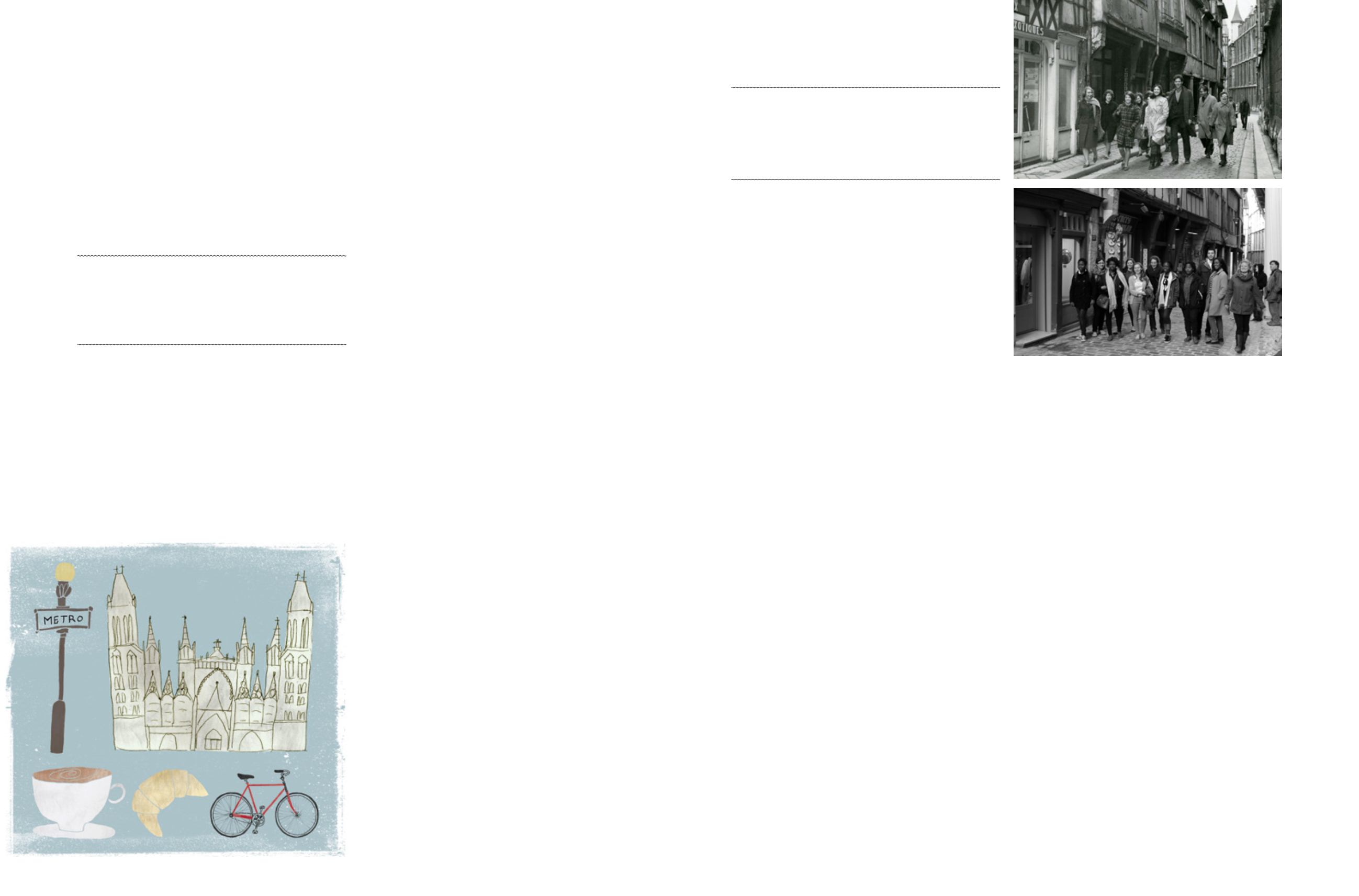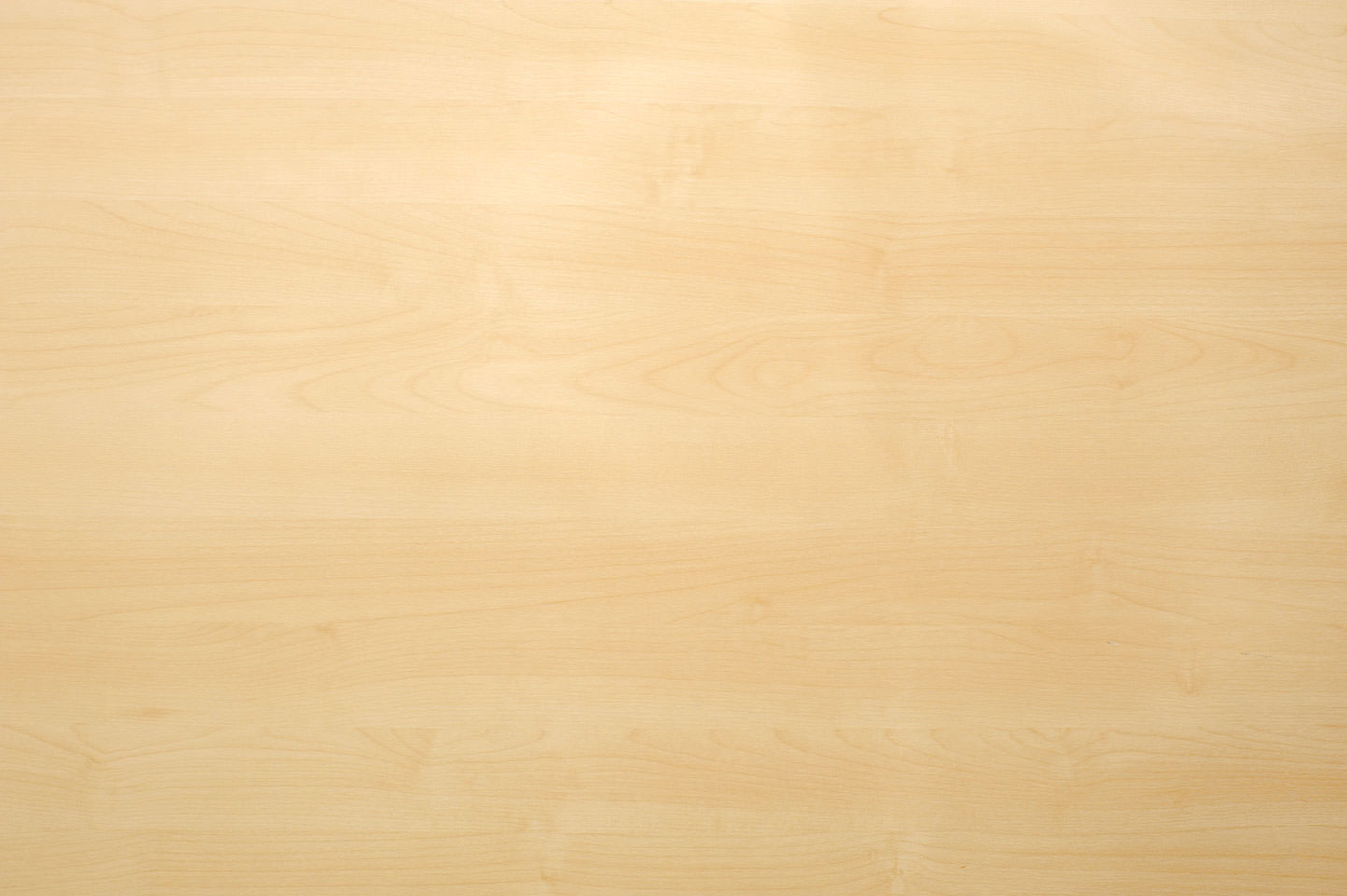

18
19
movie: the student ship steaming toward a year in France—
a romantic comedy, wouldn't you think?
Other articles through the 1980s surprised me with how strong
the tradition proved, how little changed over the first 25 years:
An initial period in Paris, then off to the thoroughly modern
buildings of the University of Rouen, excursions to Mont-Saint-
Michel and the Loire, and the glorious year-end trip to the south
of France. Students took eight courses, which lasted all year long,
including the famous optional course, in regular university classes
shoulder-to-shoulder with “real” French students. And, of course,
there were the family homestays, since the beginning the pillar
of our program: my French brother, my French mother, said the
students back then, and say the students still today.
In a series of remarkable articles from 1964, ’65 and ’66,
student writers recount in
The Hill News
their adventures in
France. I recognize it all: the university buildings are filthy and
full of smoke; French students lounge in the corridors and dis-
tribute political pamphlets, showing little inclination to practice
intercollegiate sports or go to fraternity parties. Our students
rave about the pastries, the cheeses, the warmth of French fami-
lies. And then, as now, they love to travel. France's generous
vacation schedule permits excursions all over the continent.
Much has remained the same, but many things have changed.
In 1966, 34 students went to France; this fall we are sending
eight. Half of those in 1966, 17, bought scooters; others regu-
larly hitchhiked. Today, I hazard to say that none will purchase
scooters and none will hitchhike. Those perilous transportations
have long since gone the way of the
Aurelia
.
By the mid-90s, most students no longer wanted to stay the
year, but only a semester, so we let that happen. The opening
Water Lilies on Walls
By Shayla Snyder Witherell ’11
Reflections on First-Year Encounters
with the French
The Franco-Laurentian
Connection
By Roy Caldwell
fifty years in five minutes
emories from France return to me outlined in
Monet’s impressionist brushstrokes. The weathered
grey gargoyles and saints of the Cathédrale Notre-
Dame de Rouen glared at me from their perch on
the multi-faceted façade, their countenances becoming warmer
as winter days lengthened to the brighter days of mid-spring.
When I think of Paris and of Giverny, the water lilies float on
walls of the Musée de l’Orangerie and reflect in the water under
the Japanese bridge. The iconic cliffs at Étretat, their mottled
white, black and grey layers, tower above the blue sea lapping at
their base. At the end of my four short months on the Global
The following is adapted from remarks offered by French professor
Roy Caldwell at a banquet during the France Program’s “affinity
reunion” on campus on May 31, 2014. He began by explaining that
in order to learn about the program’s early history, he “climb(ed)
into the stacks of ODY, where I consulted dusty
Gridirons
and
yellowed copies of
The Hill News.
”
hese, I think, have been the directors: Andrews,
Carlisle, Jones, Pommerat, Garrity, Pierce, van
Lent, McHugh, Dargan, Caldwell, Stipa, Romey,
Jockel, DeGroat, Weiner. The teachers have been
much more difficult to recall. Little trace remains
of them in University publications. Only some
names survive. M. Virolles, our first literature
professor, received an honorary degree from St. Lawrence in 1980.
I heard some of you talk about him yesterday.
Then my memory brings forth the names of Messieurs Bâtard,
Javet and Maurice; Madame Orange, still guiding our students
through the labyrinth of French grammar; Mlle. Turgis, Madame
McDonell, and Messieurs Le Brozec and Chérif Aidara. I learned
of a certain M. Noisette de Crossard, whom I never knew but who
left a noble impression on those students who worked with him.
But especially I remember, as do many of you, the late Éliane
Pigache, heart and soul of our program from the early ’70s
until the first years of the current millennium. Let me ask you
to recall, too, her husband, the good Dr. Pigache, Bernard, the
most generous and considerate of all human beings. How I wish
he were here tonight.
In
The Hill News
of May 7, 1964, an article by Carole Ashkin-
aze ’66, a member of the initial program, reports that Professor
Oliver Andrews of the Modern Languages Department had just
returned from a six-week tour of France, where he visited other
programs in the hexagon, met with city and university officials
in Rouen, and planned the course of study for the St. Lawrence
students arriving in the fall. Dr. Andrews was interviewed by
the editor of the newspaper
Paris-Normandie
, who described
St. Lawrence as “one of the most famous American universities,”
and hailed the participants in the program as “brilliant students.”
The Franco-American collaboration was off to a great start.
Another article reports that 25 students had been selected for
the “JYP” and that Dr. Andrews, accompanied by Dr. Robert
Carlisle of History, would direct. It further notes that the group
would be departing in early September for Le Havre–now get
this–aboard the
Aurelia
, a student ship. The Atlantic crossing
lasted nine days, and there were French language courses every
morning. How the students of this first program spent the rest
of their nautical and pedagogical experience has been lost in the
mists of time. I cannot fathom why no one has made this into a
In his France Program Reunion Dinner remarks, Prof. Roy Caldwell
commented that “Much has remained the same, but many things
have changed.” These pictures, taken on Rouen’s Rue Saint Romain
in 1964, the program’s first year (top), and 2014, portray that truth.
bottom photo: Tim Wheeler '15
T
In recognition of all of this, in the next few pages we acknowledge
the two milestones that were at the hub of this year’s Reunion
Weekend, the 50th anniversary of that first program in France
and the Kenya Program’s 40th.
What lies ahead? Long-term, we can foresee St. Lawrence
adding more programs in more countries, and even higher
percentages of students taking advantage of these enriching
opportunities. As the world grows ever smaller in ever larger
ways, we will be able to say with ever more certainty that the
education St. Lawrence provides is truly global.
M
Francophone First-Year Seminar, I hiked to the top and stood
on the precipice of those cliffs. I realized then how fleeting our
time is, compared to the millennia sketched in the stratigraphy
of that weathered chalk.
I was not always at such ease. With the 50th reunion of the
France program, I was compelled to read my journal of those
four months. Six years had flown by since I had returned home
and put it away, enough time to be critical of and fascinated by
the thoughts of my 19-year-old mind as I worked through the
challenges of living abroad.
My second night in Québec, I found myself wandering the
foggy, slush-filled streets. Weighted down with soggy pant legs,
elementary French and rising panic at being lost, I wondered
if I had made the right choice. Maybe a small-town girl from
rural New York State wasn’t meant to try this experience. Safely
in the home of my Québécois family, frustration oozed onto my
journal page; on the verge of tears, I scribbled, “I feel clueless!”
My first-ever airplane journey shortly after that night took me
to Rouen. I decided to walk as much as I could. I walked half an
hour up the narrow, winding streets to
la fac
at Mont-Saint-Aig-
nan every morning, choosing the Rue Raffetot, a steep incline that
left me breathless and matched my uphill battle with the French
language as I struggled to be myself around my host family.
In time, both my understanding and expression of French
and my endurance for climbing the hill improved. On Sunday
afternoons in the Place du Vieux Marché, I was symbolically
warmed by the proximity of the historic flames under the cross
where Jeanne d’Arc was burned. In Paris in March, I walked for
miles one chilly yet sunny afternoon with a map as my only com-
panion, exploring the Latin Quarter. On a Saturday morning in
April, I connected with my host mother as we explored Rouen’s
Musée de la Céramique together and laughed at a silly joke that
I had come up with. The terrified girl on the dark streets of
Québec who couldn’t ask for directions in French had changed.
One semester is fleeting in the history of the 50 years of
St. Lawrence’s oldest international study program, as is 50 years
in the history of Rouen, where Monet painted the cathedral built
centuries before his time. Yet the transformational powers of the
program, and all of St. Lawrence’s off-campus programs, lie
in those transferrable acquired lessons that last a lifetime.
I wish I could say that my desire to go to France was more
profound than a superficial interest in Monet, Jeanne d’Arc and
the beauty of the French language. I often wrote in my journal,
“I can’t believe that I am really in France,” after visiting iconic
tourist attractions. Now I realize that those sites are just added
bonuses, landmarks on the canvas surrounded with the skillful
splash of light and dark colors. The challenges, the successes and
the lessons in that place are the final composition, a priceless
piece commissioned from choosing to walk the steep uphill
climb that is studying abroad.
Shayla Witherell is St. Lawrence’s assistant director of donor
relations. Her Global Francophone First-Year Seminar took her
to Québec, France and Senegal in spring 2008. Her story about
two “Laurentian for Life” couples who still enjoy skiing appears
in the Sports pages of this issue.

















